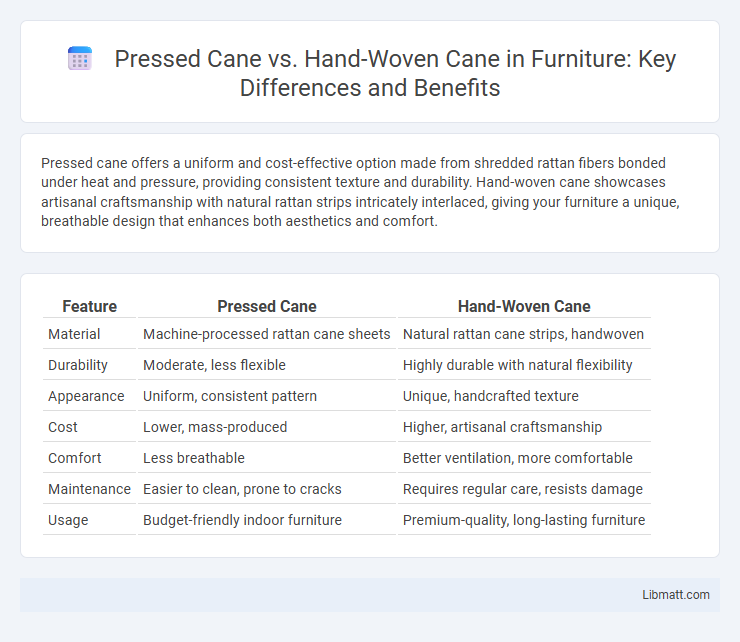Pressed cane offers a uniform and cost-effective option made from shredded rattan fibers bonded under heat and pressure, providing consistent texture and durability. Hand-woven cane showcases artisanal craftsmanship with natural rattan strips intricately interlaced, giving your furniture a unique, breathable design that enhances both aesthetics and comfort.
Table of Comparison
| Feature | Pressed Cane | Hand-Woven Cane |
|---|---|---|
| Material | Machine-processed rattan cane sheets | Natural rattan cane strips, handwoven |
| Durability | Moderate, less flexible | Highly durable with natural flexibility |
| Appearance | Uniform, consistent pattern | Unique, handcrafted texture |
| Cost | Lower, mass-produced | Higher, artisanal craftsmanship |
| Comfort | Less breathable | Better ventilation, more comfortable |
| Maintenance | Easier to clean, prone to cracks | Requires regular care, resists damage |
| Usage | Budget-friendly indoor furniture | Premium-quality, long-lasting furniture |
Introduction to Cane Work: Pressed vs. Hand-Woven
Pressed cane cane is manufactured by mechanized processes that flatten natural fibers into uniform sheets, providing consistent texture and durability ideal for mass-produced furniture. Hand-woven cane involves skilled artisans interlacing natural rattan strands by hand, creating intricate patterns that offer superior breathability and aesthetic appeal. The distinction between pressed and hand-woven cane lies in craftsmanship and material authenticity, influencing durability, flexibility, and overall design quality in cane work.
Understanding Pressed Cane Technique
Pressed cane technique involves flattening natural rattan strips into thin sheets, which are then punched with holes to create the familiar mesh pattern seen in cane furniture. This method produces a uniform, consistent design but lacks the flexibility and strength found in hand-woven cane, which is individually interlaced by skilled artisans. Your choice between pressed and hand-woven cane affects durability, aesthetic authenticity, and overall quality of the furniture.
The Craft of Hand-Woven Cane
Hand-woven cane showcases the meticulous artistry of intertwining natural rattan fibers by skilled craftsmen, offering durability and unique aesthetic patterns that pressed cane lacks. This traditional technique ensures enhanced breathability and flexibility, making furniture both comfortable and long-lasting. Pressed cane, manufactured through machine compression, often compromises on strength and texture, missing the intricate handcrafted details of hand-woven cane.
Materials Used in Pressed Cane and Hand-Woven Cane
Pressed cane is made from shredded rattan or bamboo fibers that are compressed and glued under high pressure, resulting in a uniform, stiff sheet commonly used in furniture seats and backs. Hand-woven cane features natural rattan strands woven meticulously by artisans, preserving the material's flexibility, breathability, and traditional aesthetic. Your choice between pressed and hand-woven cane will affect durability, texture, and overall appearance due to the distinct materials and production techniques involved.
Visual Differences: Identifying Each Style
Pressed cane features a uniform, machine-made texture with perfectly symmetrical holes and consistent patterns, creating a smooth and polished appearance. Hand-woven cane displays slight irregularities and variations in weave tightness, showcasing natural craftsmanship and unique, organic designs. Visual identification relies on recognizing the mechanical precision of pressed cane versus the artisanal, uneven qualities of hand-woven patterns.
Durability: Long-Term Performance Comparison
Pressed cane, manufactured by compressing cane strips under heat and pressure, offers consistent strength but can be more prone to cracking over time compared to hand-woven cane. Hand-woven cane, crafted by weaving natural rattan strands, provides superior flexibility and resilience, allowing it to withstand prolonged use without significant damage. The intricate weaving pattern in hand-woven cane enhances its durability, making it a preferred choice for long-term furniture performance.
Comfort and Ergonomics: Which is Better?
Hand-woven cane offers superior comfort and ergonomics due to its natural flexibility and breathability, allowing better air circulation and reducing pressure points on your body. Pressed cane, while more uniform and rigid, lacks the adaptive qualities that conform to your posture over time, potentially leading to less ergonomic support. For prolonged use, hand-woven cane furniture is generally better suited to maintain comfort and promote healthy seating alignment.
Maintenance and Repair Considerations
Pressed cane requires less frequent maintenance but can be more challenging to repair due to its rigid, machine-formed structure that limits flexibility. Hand-woven cane offers easier repair options since damaged strands can be individually replaced, preserving the integrity of the weave. Regular cleaning and conditioning extend the lifespan of both types, with hand-woven cane benefiting from more careful, gentle handling to prevent fraying or sagging.
Cost Implications: Pressed Cane vs. Hand-Woven Cane
Pressed cane offers a budget-friendly alternative with lower production costs due to machine manufacturing, making it ideal for cost-conscious projects. Hand-woven cane demands higher labor and time investment, resulting in increased prices that reflect its artisanal craftsmanship and durability. Choosing between pressed and hand-woven cane significantly impacts overall expenses, with pressed cane suited for economical options and hand-woven cane valued for long-term quality and aesthetic appeal.
Choosing the Right Cane for Your Furniture
Pressed cane offers uniformity and cost-effectiveness, making it ideal for budget-friendly or modern furniture designs requiring consistent patterns. Hand-woven cane provides exceptional durability and unique craftsmanship, enhancing traditional or high-end furniture with natural texture and timeless appeal. Selecting the right cane depends on desired aesthetics, budget, and the level of authenticity and strength needed for your furniture pieces.
pressed cane vs hand-woven cane Infographic

 libmatt.com
libmatt.com